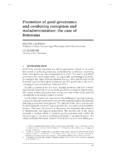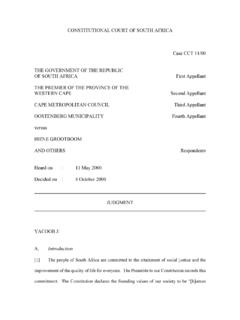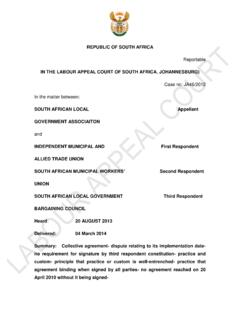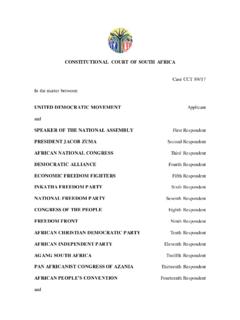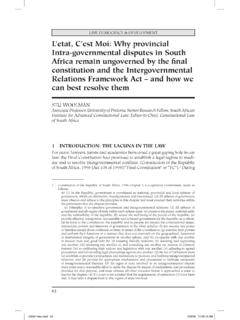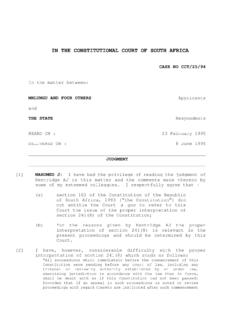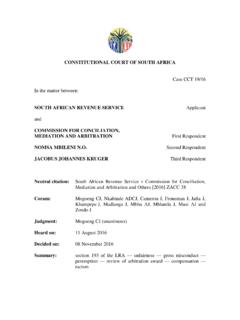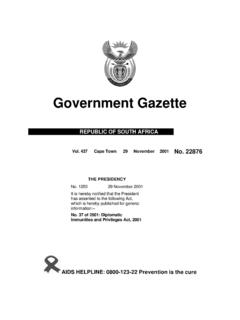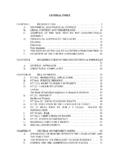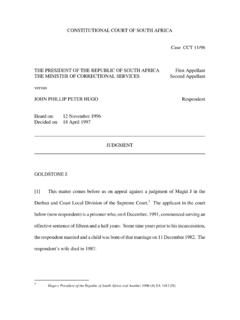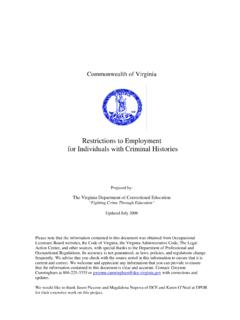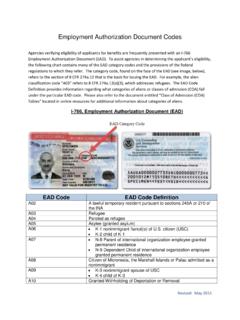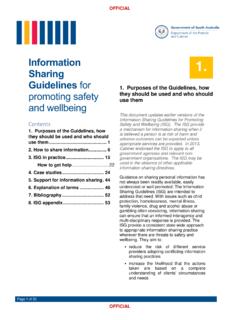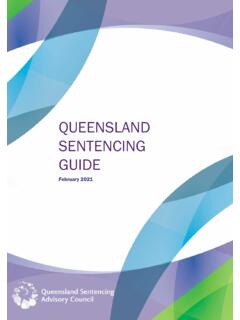Transcription of Critical Criminal Law James Grant - SAFLII
1 Critical Criminal Law James Grant ISBN: 978-0-620-78805-2. Critical Criminal Law RS 02 of 2018. About the book Grant holds a PhD in Criminal Law. He taught Criminal law for 14 years at the University of the Witwatersrand and is unquestionably a leader in the field. He is now a practicing Advocate and brings his practical experience to enliven the theory of Criminal law. He remains affiliated to Wits Law School as a visiting Associate Professor of Law. His PhD thesis is about to be published by Juta and Co, SA. Grant is also the proud author of two of the chapters in the leading text on Criminal Procedure in South Africa: The Commentary on the Criminal Procedure Act. Grant extracts and collates the principles that can sometimes be complex, in a way that allows for a clear understanding of the current law. This text will show that, to a very large extent, South African Criminal Law maps onto most ordinary intuitions about what is fair and just.
2 Where it is not, Grant explains how this may be understood and the extent to which it may be reconciled with defensible principles. This analysis is crucial for understanding Criminal law in SA, but what follows - where Grant subjects the law to a Critical analysis - is what sets this work apart and makes it a necessary tool for anyone who wants to practice or to properly understand what Criminal law is in South Africa and what it should be. This text is live and will continue to be added to an updated. As it stands it covers all general principles with the exception of a chapter on attempt liability and three chapters on specific grounds of justification under unlawfulness (private defence, necessity, and consent). These four remaining chapters will be completed soon and hopefully included in the next revision service. It is intended as a text of principles of Criminal law. Above all though, one advantage of this text is that it is and will always be utterly up to date at least to the last 6 months.
3 Each year 2. revision services will be undertaken in July and January to bring the book up to speed with any new case law or statutory changes of any significance. James Grant Page | 2. Critical Criminal Law RS 02 of 2018. About the book Copyright Law to Date Acknowledgments PART I: INTRODUCTION. Chapter 01: Introduction Introduction Voluntariness Unlawfulness Causation capacity Fault Contemporeneity Onus of Proof Conclusion Chapter 02: Criminal Law in 4D. Introduction Requirements Perspectives A. Objective Normative B. Objective Reality C. Objective Constrained D. Subjective Conclusion Chapter 03: Contemporaneity Introduction James Grant Page | 3. Critical Criminal Law RS 02 of 2018. Cases Thabo Meli Chiswibo Masilela Conclusion PART II: CONDUCT. Chapter 04: Voluntariness Introduction Fundamental Definition? Consciousness Absolute Force Sane and Insane Involuntariness/Automatism Proof of Involuntariness: Working definition Chapter 05: Antecedent Liability Introduction The Reach of Antecedent Liability Schoonwinkel Victor Circumstance and Consequence crimes Van Rensburg Conclusion Chapter 06: Conduct Acts and Omissions Recognised Legal Duties James Grant Page | 4.
4 Critical Criminal Law RS 02 of 2018. Situation crimes Chapter 7 Causation Introduction Preliminary points Hastening Death Common Purpose Two stage enquiry Factual Causation Too wide Legal Causation Individualisation Tests Foreseeability Tests Adequate Cause Novus Actus Interveniens Critical Comparison of Adequate cause and Novus Actus Interveniens Causation and Medical Intervention The Question Medical Intervention Severity of Wound Quality of Medical Care Can Medical Intervention serve as a novus actus interveniens? 1 Non-Lethal (treatable) wounds 2 Lethal (untreatable) wounds Grey Areas and Trends Conclusion PART III: UNLAWFULNESS. James Grant Page | 5. Critical Criminal Law RS 02 of 2018. Chapter 08: Unlawfulness Introduction Introduction Ultimate test Pervasive Extensive Effect Reasonable Person Test No exceptions not excluded by strict liability PART IV. capacity . Chapter 09 Responsibility: Introduction Introduction capacity Recognised Grounds of Incapacity Conclusion Chapter 10 capacity to Appreciate the Wrongfulness of One's Conduct Introduction Does it matter what it means?
5 M'Naghten Rules Moral Standard? Legal Standard? Conclusion Chapter 11: capacity to Conduct oneself in accordance with an Appreciation of Wrongfulness and Voluntariness Introduction Logic of this discussion capacity for self-control defined? Voluntariness Defined? Distinction? James Grant Page | 6. Critical Criminal Law RS 02 of 2018. Burchell Snyman Judiciary Analysis of Considerations Conative/Cognitive Requirement? Consciousness Goal directedness Trigger Conclusion Chapter 12: Pathological Non-Responsibility Introduction Meaningless Improper or Unfounded Concerns Dubious Foundation Pathology In English In Law In the Social Sciences Conclusion Endogenous Origin Social Sciences In Law Dangerousness Redundancy Conclusion Chapter 13 Non-pathological Non-Responsibility Introduction James Grant Page | 7. Critical Criminal Law RS 02 of 2018. Provocation' in England and the USA. Subjective element in England Subjective element in the USA.
6 Objective element: the Reasonable Person Development of the Defence in South Africa History of the Defence Recent Developments Eadie The End of Non-pathological Incapacity? S v Ramdass Non-pathological Incapacity versus Pathological (Mental Illness/Defect) Incapacity Defining the non-condition'. Non-pathological Duration Dysfunction and Deviance Conclusion PART V. FAULT. Chapter 14 Fault Introduction Strict liability Versari in re illicita Chapter 15 Intention Introduction Subjective inquiry Intention and motive Types of intention Dolus directus Dolus indirectus James Grant Page | 8. Critical Criminal Law RS 02 of 2018. Dolus eventualis Dolus indeterminatus? Conclusion Chapter 16 Negligence Introduction Possible offences The Test The Reasonable Person Qualifications Criticism Degree of negligence: Guarding against risk: Foresight of actual consequence Conclusion PART VI. PRINCIPLES AT WORK. Chapter 17. Introduction General Principles The Effect of a Mistake Material mistake Genuine Mistake Error in objecto and aberratio ictus Error in objecto Aberratio Ictus Versari or bad luck Mistake of law James Grant Page | 9.
7 Critical Criminal Law RS 02 of 2018. Extent of Mistake Negligence Obtaining legal opinion Mistake as to Unlawfulness Mistake as to Causal Sequence or Act Intoxication Chretien Criminal Law Amendment Act (1 of 1988). Antecedent Liability Chapter 18 Fault in Statutory Offences Introduction Strict liability Strict Liability May be Express or Tacit Compromise Which form of Fault Illustration Onus of proof Chapter 19 Participation in crime Introduction Socii criminis Categories Perpetrators Imputation Forms of Common Purpose What Common Purpose is Not Liability Clouds Common Purpose and Mens Rea James Grant Page | 10. Critical Criminal Law RS 02 of 2018. Accomplices Eiehandige misdade (own hands crime). Dependence Furthers Unlawful Intentional Order of inquiry Causation Causation and agency liability Causation and Accomplice Liability Common Purpose Eiehandige misdade ANNEXURES. James Grant Page | 11. Critical Criminal Law RS 02 of 2018.
8 Copyright Licensees may copy, distribute, display and perform the work and make derivative works and remixes based on it only if they give the author or licensor the credits (attribution) in the manner specified by these. Law to Date This text states the law as it is on 31 January 2018. Its next revision service (RS2) is due end July 2018 to take account of any development to end June 2018. Acknowledgments I wish to thank my father John Grant for showing me at the age of about eight years old . how to steal train sets. This lesson triggered in me a moral dilemma that has driven me to question morality and law every day. I am thankful to my friends, teachers, lecturers, mentors, Merle Friedman, Roger Whiting, Andrew Paizes, Mark Leon, Thaddeus Metz, Eusibius McKaiser, Johnathan Klaaren, and Michael Greyling for giving me the tools to work on my moral and legal dilemmas and to live an examined life. Finally, I must thank my wonderful wife Michelle and my late mother June Grant , who have been my exemplars of moral icons.
9 James Grant Page | 12. PART I: INTRODUCTION. Critical Criminal Law RS 02 of 2018. Chapter 01: Introduction Introduction One is only criminally liable and subject to punishment if the following requirements are met. 1 It must be proved, beyond any reasonable doubt, that the accused committed some wrongful conduct which coincided in time 2 with a culpable/guilty mental state. For illustration purposes, it will be helpful to bear the definition of the crimes of murder and culpable homicide in mind. Murder is defined as the intentional unlawful killing of another human being. Culpable homicide is defined as the negligent unlawful killing of another human being. Notably, the two crimes are identical, except that murder requires intention, while culpable homicide requires negligence. 3. Wrongful/Unlawful 4 conduct (also known as the actus reus) requires conduct, in the form of an act or omission, which is voluntary and is wrongful/unlawful.
10 A culpable mental state (also known as mens rea) requires, on the current law, at least capacity ' and at least for all serious crimes some form of fault (intention or negligence). 1 Other ways of grouping requirements exist (CR Snyman Criminal Law 5th ed (2008) 33ff). However, this method is consistent with practice and captures all that is necessary. Snyman argues that a separate requirement of compliance with the definitional elements' is required since each crime prohibits particular conduct, not just any conduct (ibid 30 & 4). He is obviously correct. However, the enquiry into conduct must necessarily concern itself with conduct that is prohibited, and not just any conduct. When one enquires into whether conduct may be attributed to the accused, the question is necessarily whether the accused did what is prohibited under some crime. As Visser and Mar note conduct in the Criminal law refers not only to action or inaction, but to such action or inaction in all the relevant circumstances of the particular proscription in question' (PJ Visser & MC Mar Visser & Vorster's General Principles of Criminal Law Through the Cases 3rd ed (1990) 46).
